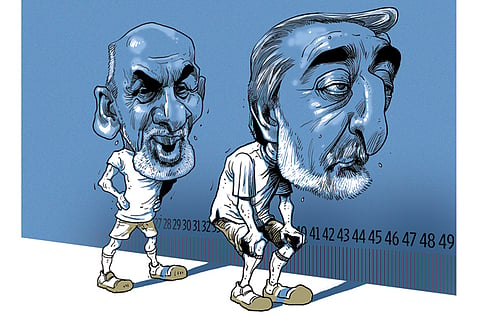Afghanistan at crossroads after poll
The new government will need to keep Washington on its side while not torpedoing talks with Taliban

The Afghan authorities released on April 26 preliminary results showing that a second round ballot in late May or June will be almost certainly needed to decide the country’s landmark presidential election. With all votes now counted, except around a reported half a million that are still being investigated for fraud, neither of the two front-runners have secured the necessary 50 per cent needed to win in the first round.
The election process is historic as it marks the end of the post-September 11 era of President Hamid Karzai. And it will ultimately lead to the first democratic transfer of power in Afghanistan’s history.
The two candidates in the run-off ballot, Abdullah Abdullah (who won 44.9 per cent of the preliminary first round vote) and Ashraf Gani (who secured 31.5 per cent), both held high profile roles in Karzai’s first administration. Abdullah, a former foreign minister and trained medical doctor, finished second in the 2009 presidential election, while Ashraf Gani, an economist and former World Bank executive, was formerly Afghan finance minister.
While a run-off could still potentially be avoided if Abdullah and Gani do an electoral deal, both have said they would like the next round to progress. In coming days, much attention will therefore focus on whether one of them reaches a pact with Zalmai Rassoul, also a former foreign minister and medical doctor, who finished third in the first round of elections with 11.5 per cent; and/or Abdul Rasoul Sayyaf, a former lawmaker and religious scholar, who won 7.1 per cent. Abdullah, whose support base is concentrated in the ethnic Tajik community, has already made overtures to Rassoul who, like Gani and Sayyaf, is from the country’s majority Pashtun community.
The electoral authorities also confirmed the high turnout in the first round ballot on April 5 with almost seven of 12 million eligible people casting a ballot, a third of them women, well in excess of the approximately 4.5 million people who voted in 2009. This high turnout, plus the absence of catastrophic Taliban violence at the polls, has fuelled optimism that this ballot process could prove a pivot-point in the country’s troubled history.
While this is possible, there are nonetheless massive political, economic and security risks on the horizon. The success of the election winner in tackling these will do much to determine the stability of the new government, and future direction of the country.
Securing US concessions
The number one item for the new president will be bolstering domestic security. Unlike Karzai, both Abdullah and Gani have endorsed the need for a long-term deal with US and Nato forces.
However, in order to create the ‘political space’ for what would be a controversial agreement with some of the populace, the new president will need to secure concessions from Washington. This could mean protracted negotiations which will frustrate the Obama administration.
While it is likely than a deal will ultimately be reached, there is a growing possibility that US and Nato forces may pull out completely in 2014. This could prove catastrophic for the new government.
This is widely recognised internationally, but the financial and human cost of the Afghan military presence is unpopular in many western countries. Moreover, delays in signing a deal (Washington hoped to reach agreement last year with Karzai) means logistical and personnel complications of extending the troop presence are growing.
Major issues that will need to be resolved include: the fate of Taliban prisoners; extending immunity for US military personnel in the country; and any continuing US mandate to perform counter-terrorism mission in Afghanistan. These are points where the new government will walk a tightrope between keeping Washington on side, whilst not torpedoing the peace dialogue with the Taliban.
Should a security deal be secured, a residual force (US and Nato combined) of around 8,000-12,000 troops is most likely. Importantly, this would also help ensure continued extensive funding and training for the approximately 350,000 strong Afghan police and military forces which may otherwise disintegrate.
While a continuing international force would provide a stabilising presence, Afghanistan nonetheless faces the possibility of much greater instability from a renewed Taliban counter-offensive. This is why another key priority for the new president will be advancing reconciliation with the Taliban.
Pakistan’s influence could be key in facilitating any eventual peace deal. While doubts remain about that country’s ability and willingness to facilitate such an agreement, a potentially significant move was made last month when Pakistani government representatives entered into formal peace talks with the Taliban in North Waziristan.
Turning to the economic front, the new president will come into office at a very difficult moment. Since 2001, the fast-growing economy has become steadily more dependent on foreign aid.
Economic risks would be particularly intense if international troops are fully withdrawn. This could see foreign aid cut back markedly.
Another key problem is that there has been only very limited success in economic diversification since 2001. The danger is that, as aid is reduced, the economy becomes increasingly dependent upon drug exports such as opium and heroin.
Taken overall, Afghanistan is thus at a crossroads. There remains a significant prospect of much greater economic, political and security instability. This is especially probable if international forces are completely withdrawn in 2014 which could pave the way for the government’s collapse.
However, a different pathway is possible through a successful, speedy transfer of democratic power combined with an eventual reconciliation deal with the Taliban. This would consolidate the power and legitimacy of the new president and government, and help preserve some of the fragile gains in Afghanistan since 2001.
Andrew Hammond is a former UK government special adviser in the government of Tony Blair, and an Associate at LSE IDEAS at the London School of Economics.
Sign up for the Daily Briefing
Get the latest news and updates straight to your inbox



